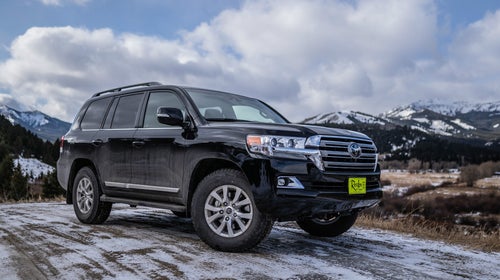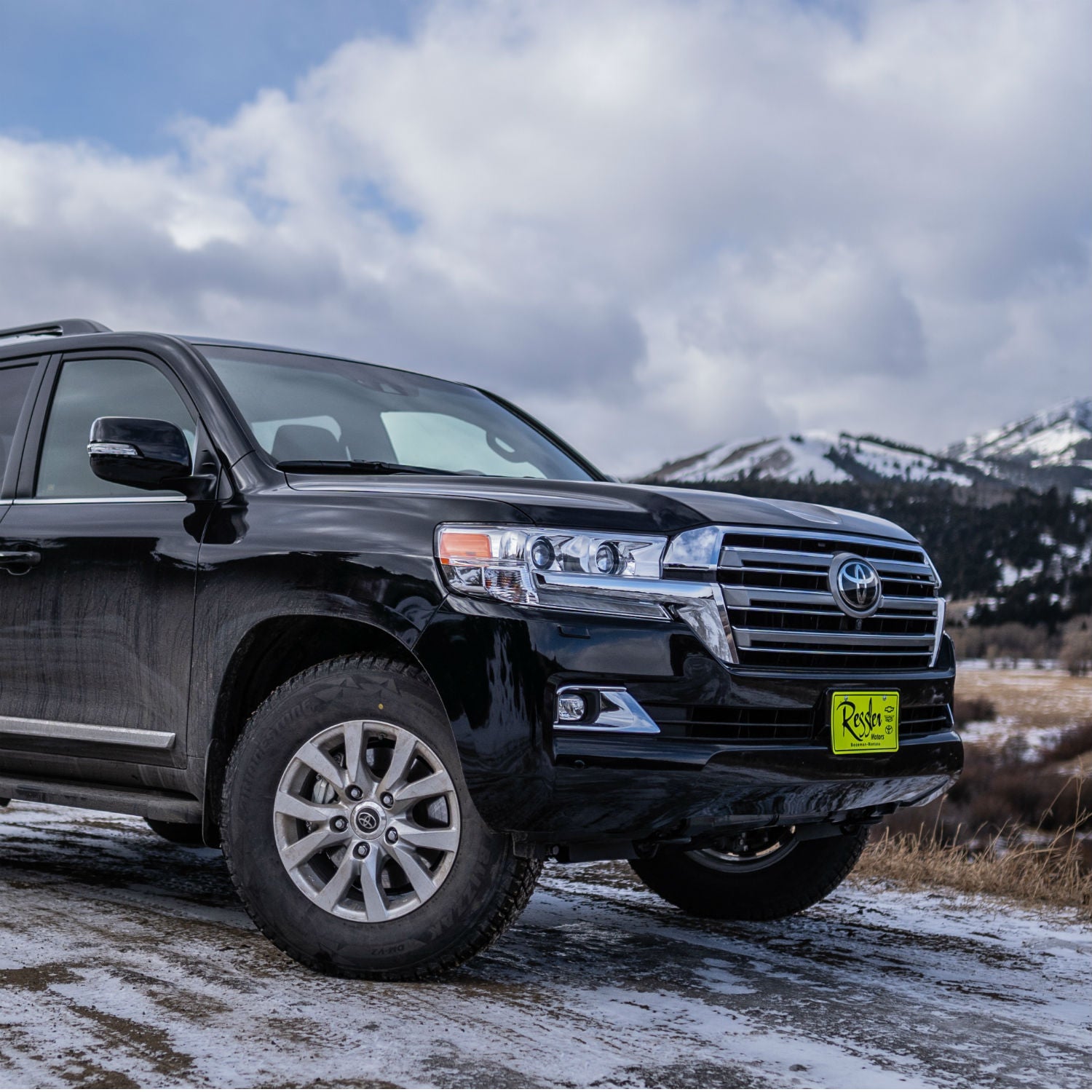Toyota only sells about 3,000 Land Cruisers a year in the United States these days. That’s of the volume of something like the RAV4 or Camry. The current model was launched way back in 2008 and is significantly slower, less spacious, and uses more fuel than any of the three-row SUV competition, which all cost less money, too. So why did my fiancée and I just buy one? Let’s start with why the Land Cruiser is wrong for a lot of people and then move onto the things it gets very, very right.
Downsides to the Toyota Land Cruiser
Weight: The Land Cruiser weighs 5,815 pounds. To put that in perspective, the Toyota Tundra pickup, which has the same engine, starts out at 5,170 pounds. Something like the larger, more spacious Ford Expedition weighs 5,443 pounds.
Fuel Economy: The Land Cruiser averages 14 miles per gallon, according to the EPA. We’ve been getting ten. You can thank that weight and the simple 5.7-liter V-8 it shares with the smaller Tundra for that. The bigger, faster Expedition averages 20 miles per gallon.
Design: I mean this in terms of pleasing the eye; inside and out, the Land Cruiser looks more like a Highlander than a luxury SUV. The exterior is utterly forgettable, while the interior suffers from parts-bin switchgear and a heavy reliance on silver-colored plastics.
Infotainment: Our 2020 Land Cruiser has what has to be the most outdated infotainment system still on sale in 2019. There’s a nine-inch touchscreen, but its resolution is poor, and it doesn’t include Android Auto or Apple CarPlay. That means you’re left with Toyota’s own navigation program, which looks like it was developed in the mid-2000s. The system can sync with our phones using Bluetooth, in order to play music and make phone calls, but can’t display any details of what you’re listening to on its screen or control anything but volume. It also lacks the ability to communicate with your phone when you’re away from the vehicle, so you can’t use your phone to remote-start the Land Cruiser.
Third-Row Space: The first and second rows of seats in the Land Cruiser are extremely spacious and comfortable, even when filled to capacity. The third row? Not so much. Because the full-size spare is mounted underneath the vehicle between its frame rails, there’s no room for the third row to fold into the floor. Instead, it splits in the middle, and both halves fold up to the sides. Sitting back there also feels like sitting on the floor, and as far as I can tell (and I’m six foot two), there are approximately zero inches of legroom. There’s no room behind the third row for luggage when it’s in use, and the seats impair cargo space significantly when folded up.
Price: The Land Cruiser starts at $85,315. The only option is a $2,220 rear-seat entertainment system, plus a special Heritage Edition that fits fancy wheels and some badges, for a total price of $87,645. There’s no way to get around that being an extremely large sum of money, particularly when you consider that this model has been around for almost 12 years and that it can’t even connect to your phone properly.
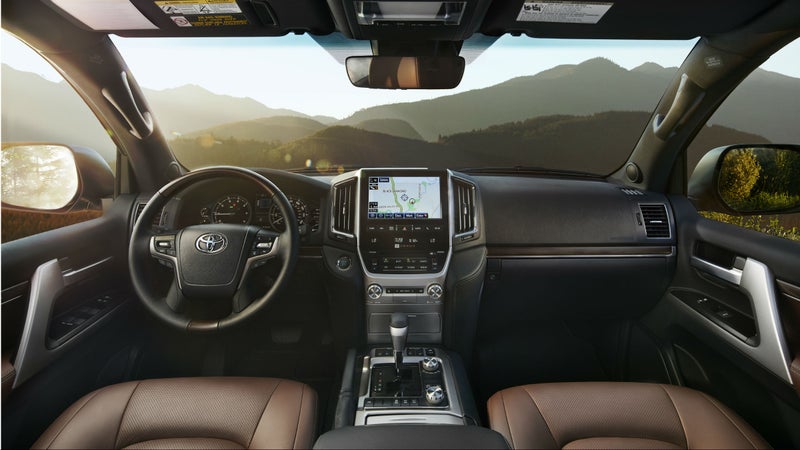
What the Land Cruiser Gets Right
Durability: Where any other Toyota is designed and durability-tested to fulfill a 15-year service life of typical on-road use, the company builds and tests the Land Cruiser to ensure it can survive 25 years of constant off-road use in good condition. Unlike virtually every other vehicle on the market, the Land Cruiser is not built down to a price, it’s built up to this requirement.
Serviceability: Because the Land Cruiser is fitted with the relatively simple and very common 5.7-liter V-8 from the Tundra, we’ll be able to find parts for it at every auto store in North America (and on many other continents). And any auto shop will have experience working on that power train. Ever waited a week for a part to get shipped from another country while you and your vehicle are stranded at a small mechanic’s shop in the middle of nowhere? I have, but that will never, ever happen with the Land Cruiser.
Ride Quality: Take one of the strongest ladder frames ever created, bolt a body on top with vibration-isolating rubber dampers, then fit the highest-quality suspension system your company knows how to make, and you’re going to get a truck that rides like a bank vault floating through the air. This is one area where the Land Cruiser’s immense weight helps. Due to the high sprung-to-unsprung weight ratio, the movement of the wheels, tires, and rear axle has remarkably little influence over the vehicle’s body. That’s why this live-rear-axle vehicle rides better than alternatives fitted with independent rear suspension.
Vision: It’s fashionable right now to design cars and trucks with slim glass houses—that’s the portion of the vehicle wrapped in windows. But what looks cool on the outside translates to incredibly poor vision from the inside out. The Land Cruiser may not be trendy, but you can see out of its huge windows and windshield unimpaired, and that helps you navigate everything from city traffic to off-road obstacles with total confidence.
Features: The buttons on the Land Cruiser are pulled out of of an economy car, the silver accents are all plastic, and the infotainment system is awful, but the compromises stop there. The center-console storage bin? That’s a powered fridge you can use to keep drinks or snacks chilled. It’s big enough for a bottle of champagne. The cubby where the ashtray used to be? That’s a capacitive charger you can use to power up your Apple Watch. The steering wheel? It’s heated. This SUV features every electronic driver aid possible this side of autonomous driving. The big touchscreen displays obstacles when you’re off-road. Jeeps do that, too, but the Land Cruiser shows you what’s to your sides and rear as well as what’s in front of you. I have it set to do that on the road, too, any time we go below five miles per hour. I could go on, but the list would end up longer than this article. As I explained to my fiancée, Virginia, if it’s a thing, the Land Cruiser has it. And unlike most other vehicles, it won’t be a thing that will break.
Traction: The Land Cruiser is fitted with full-time four-wheel drive. That means it nominally operates in all-wheel drive, but at the push of a button, you can lock the center differential and put it in four-wheel drive. That center diff is , which splits 40 percent of its torque to the front axle and 60 percent to the rear in normal driving. Should one wheel break traction, it can redirect up to 75 percent of that torque to the axle with the most traction. On a paved road, in the kind of winter weather we’ve been having here in Montana, that’s the best arrangement possible. It allows the truck to find traction as we drive on constantly varying surfaces. Locking the center diff splits torque 50/50; this achieves more traction than even a best-possible all-wheel-drive system like this one can, but it can only be employed in slippery conditions. On top of that, there’s also a traction-control-based system that tweaks individual brake calipers to mimic the function of locking axle diffs, and even an off-road cruise-control system that manages traction for you while maintaining a constant (very low) speed.
Articulation and Angles: Sway bars transfer force from one side of a car to the other, helping to control body roll in corners. That’s a huge help in high-speed corners on the road but limits wheel articulation off-road. So disconnecting those sway bars on dirt helps your wheels stay in contact with the driving surface. Only a very small number of the most capable off-road vehicles are equipped with disconnecting sway bars. And unlike other solutions, Toyota developed a system for the Land Cruiser that is and automatic to connect and disconnect them, meaning it’s much more robust than the electronic alternative. In action, you never need to think about it; on the road, the vehicle corners flat, but over uneven obstacles, your wheels are capable of dropping further beneath the truck. This system pairs with what are extremely impressive approach, departure, and breakover angles for such a large SUV, along with a very short wheelbase, to grant the Land Cruiser off-road ability rivaling that of smaller, less refined vehicles, like a Jeep Wrangler.
Lighting: Every lighting element that I’ve been able to find, inside and out, is LED. For stuff like the brake lights and interior lights, that means I’ll never have to replace a bulb. Up front it means the stock headlights are the best stock headlights I’ve ever used. They have an incredibly wide spread of totally even, smooth coverage and project nearly as far down a dark road as an aftermarket lighting system.
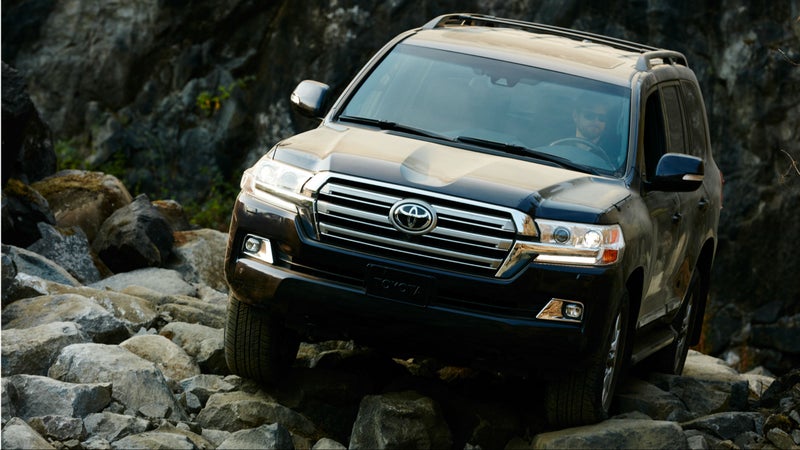
Why We Need One
Where we live, in Bozeman, Montana, weather conditions are extreme and unpredictable. The nearest NOAA radar station is 175 miles away, in Great Falls, and can’t penetrate the mountains surrounding it, so there are effectively no trustworthy weather forecasts for the area. Blizzards can happen any month of the year, and we drive off-road every single day to take the dogs for a hike, visit friends, and just get from point A to point B. The road-critter situation here is very real and very dangerous.
And that’s just here at home. We also drive all over the West Coast, from southern Baja to northern Alaska, while carrying all the camping gear you’d expect, plus three big dogs. Heck, just between people and dogs, we load the truck up with 555 pounds every time we leave the driveway.
I can’t think of a vehicle that can tackle all those challenges together, and do that not just for a few years but for a few decades. In fact, a stock Land Cruiser can’t either, which is why we’re modifying it. Another thing that’s great about these things? Off-road accessories are widely available, and there’s a solid knowledge base around getting the most out of this platform.
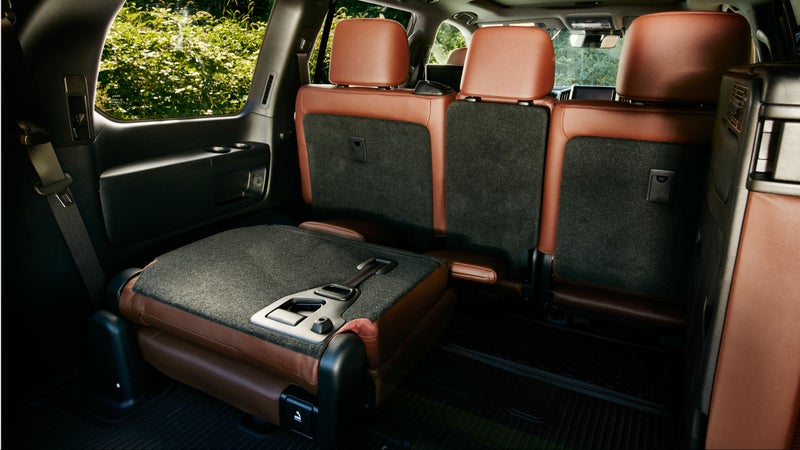
What We Plan to Do
This is going to be Virginia’s daily driver. This SUV gives her the ability to drive around Montana, or anywhere else, in total confidence that she won’t get stuck, break down, or have her truck disabled if she hits a deer. So we need more traction, the ability to self recover, and protection against those aforementioned road critters as well as common off-road obstacles. And we intend to achieve those merits without ruining what makes the stock Land Cruiser so good in the first place. I’ll cover these changes periodically in future articles, hopefully informing your ability to create trucks that are also peerlessly capable off-road but which remain refined and safe on highways.
Tires: We put on the Land Cruiser the same day we bought it. Those are the , which are purpose-built for heavier vehicles like crossovers and SUVs. They’re already inspiring a huge amount of confidence. While driving on sheet ice at 5 A.M. the other morning, I had to perform an emergency swerve at 35 miles per hour to avoid a drunk driver. The tires only broke traction momentarily, remained controllable while sliding, and are the reason I was able to avoid crashing a brand-new vehicle. We’ll keep those on until the snow clears, then fit a larger set of all-terrain tires for summer but make sure they’re small enough that the spare fits in the stock location.
Wheels: To make sure those larger off-road tires clear the fenders and sway bars, we need wheels with more offset. But wheels built for off-roading tend to add a ton of weight in pursuit of the necessary strength. I’m going to run a set that carry no weight penalty, to avoid sacrificing the truck’s ride and handling.
Suspension: The Land Cruiser is 74 inches tall, and our garage has 77 inches of clearance. For that reason, and because we want to keep on-road handling as safe as it is in stock form, we plan on running a zero-lift suspension system. So why run one at all? Because high-quality aftermarket suspension systems are capable of offering better body control and improved ride quality both off-road and on. They’re also designed to handle long periods of at-the-limit performance without overheating and losing their ability to provide control as a result.
Protection: Because it builds its bumpers to the strictest vehicle-safety standards in the world, and because it’s been doing that for over 40 years, ARB makes . I hit a 200-pound kangaroo with one at about 85 mph, and there wasn’t a scratch on the truck. I can’t imagine using anything else for our Land Cruiser. The company also makes a really nice rear bumper that foregoes the usual swing-out tire carrier. I don’t want to deal with the hassle of opening a swing-out just to load the dogs into the car, and this thing adds protection without getting in the way. We’ll also replace the plastic side steps with real rock sliders, to protect the sides of the vehicle from a common off-road injury, and fit an aftermarket skid-plate system to guard important parts like the sump, transmission, and fuel tank from damage. All of these modifications will also improve the truck’s angles. A hitch-mount swing-out will bolt on and off, giving us the ability to carry additional fuel, a Hi-Lift jack, , and other bulky essentials outside the truck without adding weight or un-aerodynamic racks to our roof.
Lights: Even as good as the Land Cruiser’s stock lighting system is, quality off-road lights are brighter. These are essential for where we live, to help us spot animals with enough time to safely avoid them and to illuminate tricky trails at night.
Traction: The Land Cruiser’s electronic traction system is very good and very easy to use. I imagine it’ll be our go-to most of the time, but I still want to add locking axle differentials for those rare circumstances when nothing else will do. We’ll regear the truck when we fit those lockers, to retain the performance and fuel economy with the larger tires and added weight.
Recovery: The ARB front bumper will give us the ability to add a winch, along with those driving lights. Winches are another accessory that are rarely used but irreplaceable in extreme circumstances.
Interior: I plan to remove the third row entirely and fit a strength-rated cargo barrier that bolts to the Land Cruiser’s frame behind the second row. This will give us the space necessary to comfortably haul around all our dogs and also help keep them and us safe in a crash. I plan to leave the rest of the interior stock to avoid compromising the vehicle’s versatility or adding unnecessary weight.
Roof: Putting giant tents and stuff on your roof is dumb. So we’ll skip doing that and maybe even shave the stock roof rails and antenna to gain a little extra fit-in-the-garage space.
Why It’s the Last
According to my my old colleague Jonny Lieberman, Toyota will stop selling the Land Cruiser in the United States in 2022. The rest of the world will see an all-new design that year, and it’s possible that we may get the Lexus version of that vehicle. (and common sense) suggest that Toyota also plans to stop using the 5.7-liter V-8 in those next-generation Land Cruisers and the next Tundra, replacing it instead with a twin-turbo V-6 and probably a hybrid gasoline-electric power train, too. While undoubtedly faster and more fuel efficient, it’s unlikely that those future vehicles will be as simple, durable, and easy to work on as the current truck. If this were a BMW or a Land Rover, more power and better fuel economy would outweigh the value of simplicity. But this isn’t a BMW or Land Rover. We didn’t buy one of those because the things that make them so nice for other drivers mean they don’t meet our needs for a genuinely hard-use truck. Due to an ever increasing pressure to improve fuel economy and fulfill the luxury expectations of high-end SUV buyers, it’s unlikely that Toyota will ever produce a vehicle like this Land Cruiser again. And that’s why we plan on keeping this thing forever.
